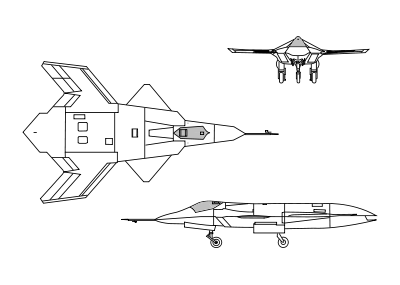- McDonnell Douglas X-36
-
X-36 X-36 in flight Role Tailless Fighter Agility Research Aircraft Manufacturer McDonnell Douglas First flight 17 May 1997 Status Retired Number built 2[1] The McDonnell Douglas X-36 Tailless Fighter Agility Research Aircraft was a subscale prototype jet designed to fly without the traditional tail surfaces used on most aircraft.
Contents
Design and development
 Planform of the X-36
Planform of the X-36
The X-36 was built to 28% scale of a possible fighter aircraft, and controlled by a pilot in a ground station virtual cockpit with a view provided by a video camera mounted in the nose of the aircraft.
For control, a canard forward of the wing was used as well as split ailerons and an advanced thrust vectoring nozzle for directional control. The X-36 was unstable in both pitch and yaw axis, so an advanced digital fly-by-wire control system was put in place to stabilize the aircraft.
First flown on May 17, 1997, it made 31 successful research flights. It handled very well, and the program is reported to have met or exceeded all project goals. McDonnell Douglas merged with Boeing in August 1997 while the test program was in progress. So the aircraft is sometimes referred to as the Boeing X-36.
The X-36 possessed high maneuverability that would be ideal for use as a fighter. Despite its potential suitability, and highly successful test-program, there have been no reports regarding the X-36's development as of 2010.
Survivors
- One X-36 is at the National Museum of the United States Air Force at Wright-Patterson Air Force Base near Dayton, Ohio. It arrived on July 16, 2003, the same day as the Boeing Bird of Prey.[2] It is displayed in the Museum's Research & Development Gallery.[3]
- Another X-36 is displayed inside the Air Force Test Flight Center Museum at Edwards Air Force Base in California.
Specifications (X-36)
Data from Designation Systems[4] American X-Vehicles[1]
General characteristics
- Crew: none
- Length: 18 ft 2.5 in (5.55 m)
- Wingspan: 10 ft 4 in (3.15 m)
- Height: 3 ft 1.5 in (0.95 m)
- Max takeoff weight: 1,250 lb (560 kg)
- Powerplant: 2 × Williams International F112 turbofan , 700 lbf (3.1 kN) each
Performance
- Maximum speed: 234 mph (375 km/h)
- Service ceiling: 20,500 ft (6,100 m)
- Thrust/weight: 0.56
See also
- Related developments
- Comparable aircraft
References
- ^ a b Jenkins, Landis, and Miller 2003. p. 46.
- ^ "Boeing Bird of Prey and X-36 Inducted into Air Force Museum". Boeing, July 16, 2003.
- ^ NASA/Boeing X-36. National Museum of the U.S. Air Force.
- ^ Boeing (McDonnell Douglas) X-36. designation-systems.net, January 9, 2006.
- Jenkins, Dennis R., Tony Landis, and Jay Miller. SP-2003-4531, "American X-Vehicles, An Inventory—X-1 to X-50". NASA, June 2003.
External links
- NASA fact sheet on the X-36 Tailless Fighter Agility Research Aircraft
- "X-36 Tailless Prototype Fighter Completes Phase 1 Flight Testing". McDonnell Douglas, July 8, 1997.
Boeing military aircraft Fighters/attack aircraft: Bombers Piston-engined transports Jet transports Tanker-transports Trainers Patrol and surveillance Reconnaissance Drones/UAVs Experimental/prototypes McDonnell and McDonnell Douglas military aircraft and spacecraft Fighters USAAF/US Air ForceUS Navy/USMCExportLicensedAttack US Navy/USMCTrainers US NavyTransports US Air ForceUS NavyLicensedHelicopters US Army/US Air ForceUS NavyXHJH · XHCH · XHRH
ExportDrones (UAVs) US NavyKDH
Experimental US Army/US Air ForceXV-1 · X-36 · F-15 STOL/MTD · Bird of Prey
Spacecraft NASAUS Air ForceUSAF/Joint Service experimental aircraft designations 1941– (X-planes) 1–25 26–50 50- X-51 · (X-52 not assigned) · X-53 · X-54 · X-55
Lists relating to aviation General Aircraft (manufacturers) · Aircraft engines (manufacturers) · Airlines (defunct) · Airports · Civil authorities · Museums · Registration prefixes · Rotorcraft (manufacturers) · TimelineMilitary Accidents/incidents Records Categories:- United States experimental aircraft 1990–1999
Wikimedia Foundation. 2010.


